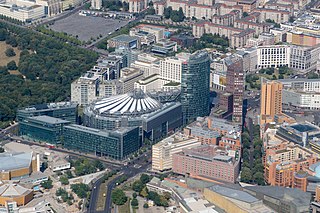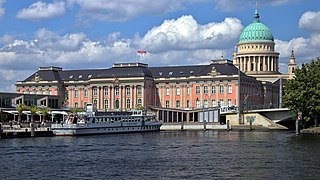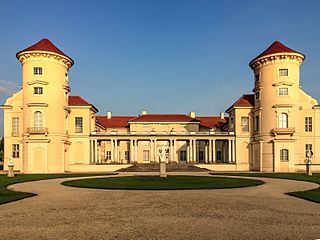
Potsdamer Platz is a public square and traffic intersection in the center of Berlin, Germany, lying about 1 km (1,100 yd) south of the Brandenburg Gate and the Reichstag, and close to the southeast corner of the Tiergarten park. It is named after the city of Potsdam, some 25 km (16 mi) to the south west, and marks the point where the old road from Potsdam passed through the city wall of Berlin at the Potsdam Gate. After developing within the space of little over a century from an intersection of rural thoroughfares into the most bustling traffic intersection in Europe, it was totally destroyed during World War II and then left desolate during the Cold War era when the Berlin Wall bisected its former location. Since German reunification, Potsdamer Platz has been the site of major redevelopment projects.

Potsdam is the capital and, with around 183,000 inhabitants, largest city of the German state of Brandenburg. It is part of the Berlin/Brandenburg Metropolitan Region. Potsdam sits on the River Havel, a tributary of the Elbe, downstream of Berlin, and lies embedded in a hilly morainic landscape dotted with many lakes, around 20 of which are located within Potsdam's city limits. It lies some 25 kilometres southwest of Berlin's city centre. The name of the city and of many of its boroughs are of Slavic origin.

Schloss Charlottenburg is a Baroque palace in Berlin, located in Charlottenburg, a district of the Charlottenburg-Wilmersdorf borough.

Carl Philipp Christian von Gontard was a German architect who worked primarily in Berlin, Potsdam, and Bayreuth in the style of late Baroque Classicism. Next to Knobelsdorff, he was considered the most important architect of the era of Frederick the Great of Prussia.

(Hans) Georg Wenzeslaus von Knobelsdorff was a painter and architect in Prussia.

The Potsdam City Palace is a building in Potsdam, Germany, located on the Old Market Square, next to the St. Nicholas' Church (Nikolaikirche). It was the second official residence of the margraves and electors of Brandenburg, later kings in Prussia, kings of Prussia and German emperors.

The Temple of Friendship is a small, round building in Sanssouci Park, Potsdam, in Germany. It was built by King Frederick II of Prussia in memory of his sister, Princess Wilhelmine of Prussia, who died in 1758. The building, in the form of a classical temple, was built south of the park's main boulevard between 1768 by architect Carl von Gontard. It complements the Temple of Antiquities, which lies due north of the boulevard on an axis with the Temple of Friendship.

The Obelisk entrance constitutes the eastern limit of Sanssouci Park in Potsdam, Germany. Following plans by Georg Wenzeslaus von Knobelsdorff, Frederick the Great ordered in 1747 that this exit from the park be built.

The Antique Temple is a small round temple in the west part of Sanssouci Park in Potsdam. Frederick the Great had the building constructed to house his collection of classical works of art, antique artifacts, coins and antique gems. Carl von Gontard created the building in 1768/69 near the New Palace north of the Central Alley, as a complement to the Temple of Friendship situated south of the Alley. Since 1921 the Antique Temple has been used as a mausoleum for members of the House of Hohenzollern and is not open to the public.

The New Palace is a palace situated on the western side of the Sanssouci park in Potsdam, Germany. The building was begun in 1763, after the end of the Seven Years' War, under King Friedrich II and was completed in 1769. It is considered to be the last great Prussian Baroque palace.

Leipziger Straße is a major thoroughfare in the central Mitte district of Berlin, capital of Germany. It runs from Leipziger Platz, an octagonal square adjacent to Potsdamer Platz in the west, to Spittelmarkt in the east. Part of the Bundesstraße 1 highway, it is today one of the city's main east–west road links.

The Marmorpalais is a former royal residence in Potsdam, near Berlin in Germany, built on the grounds of the extensive Neuer Garten on the shores of the Heiliger See. The palace was commissioned by King Frederick William II of Prussia and designed in the early Neoclassical style by the architects Carl von Gontard and Carl Gotthard Langhans. The palace remained in use by the Hohenzollern family until the early 20th century. It served as a military museum under communist rule, but has since been restored and is once again open to the public.

Babelsberg Palace lies in the eponymous park and quarter of Potsdam, the capital of the German state of Brandenburg, near Berlin. For over 50 years it was the summer residence of Prince William, later German Emperor William I and King of Prussia and his wife, Augusta of the House of Saxe-Weimar-Eisenach, German Empress and Queen of Prussia. Along with the surrounding park and other parks in the area, the Babelsberg Palace was inscribed on the UNESCO World Heritage list in 1990 for its architectural cohesion and its testimony to the power of the Prussian monarchy.

Rheinsberg Palace lies in the municipality of Rheinsberg, about 100 kilometres (62 mi) northwest of Berlin in the German district of Ostprignitz-Ruppin.
The Potsdamer Neueste Nachrichten, also known as PNN, was a regional, daily newspaper for the area in and around Potsdam, the state capital of Brandenburg in Germany. It was published by DvH Medien, a holding company founded by Dieter von Holtzbrinck. Now it is united with Tagesspiegel.

Maimi von Mirbach, full name Maria Celina Gabrielle Antoinette Freiin von Mirbach, was a German cellist and member of the Confessing Church.

The Hans Otto Theatre, named after the actor Hans Otto, is a municipal theatre in Potsdam in Germany. Its headquarters and main venue is in the Großes Haus am Tiefen See in Potsdam's cultural district on Schiffbauergasse. Other regular venues are the neighbouring historic Reithalle and occasionally the Palace Theatre in the Neues Palais.































